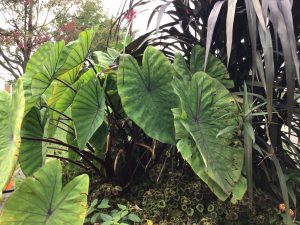Ways to create backyard paradise with tropical plant garden
By Andrew Holsinger Horticulture Educator University of Illinois Extension Services — August 5, 2022
Elephant ear is the common name of one tropical plant with big, broad leaves. The tuber or corm can be saved to be planted the next year. When planting, orient the corm or tuber correctly. Shoots are the first to emerge and should be planted upright. (Photo by Andrew Holsinger/University of Illinois Extension)
Summer may be the season for vacations, but if you can’t get away create your own backyard paradise with a tropical plant garden.
Tropical plants can be planted in the ground or in containers and overwintered inside. Treat tropical plants as annuals in the Illinois landscape.
“Tropical plants are known to be heat-loving and enjoy the humidity we have in Illinois over the summer,” says Andrew Holsinger, University of Illinois Extension horticulture educator. When grown indoors, a humidifier can be a wise investment to replicate the environment they grow best in.”
Some plants may be sensitive to direct sunlight, so be cautious in your site selection. Plants that prefer full sun may not get their intense coloring if the container is shaded at all.
Overwintering tropical plants is also an option, especially when grown in containers. Size may be a consideration as the size of the container may influence the size of your tropical plant. Pots of various sizes may be used but 24-to-36-inch diameter pots are a good start. Scout for pests before bringing plants indoors for overwintering.
The root zone is one of the most important parts of growing tropical plants. Bark-based commercial mixes do well for containers, especially when supplemented with a slow-release fertilizer and a water-retention agent. Water-absorptive materials such as sphagnum peat moss or coconut coir need to be balanced with good drainage. Add wood chips to the bottom of containers filled with potting mix.
Elephant ear is the common name of one tropical plant with big, broad leaves. The tuber or corm can be saved to be planted the next year. When planting, orient the corm or tuber correctly. Shoots are the first to emerge and should be planted upright.
Cannas are rhizomes and can have some spread. Many different types of foliage and flowers add to the beauty of this plant when in a container. Rhizomes may need to be divided as they enlarge over time.
Caladiums can make a strong visual statement with a range of colors from pure white to burgundy. This plant likes moist, shady locations. Enrich the soil with compost or humus to enhance the moisture and nutrient retention.
Tropical plants need regular maintenance. They need frequent watering when grown in containers and fertilizing with a slow-release fertilizer will allow them to grow to their fullest potential. Remove dead foliage or flowers and trim excess growth to aid in the health of the plant and keep plants balanced in the container with their counterparts.
Be sure to research the requirements and culture of the tropical plants you choose to grow. Use caution when selecting plants as some have toxic properties. For example, castor bean has toxic seeds.
To complete the tropical effect, considering adding tropical-looking hardy perennials. Clumping bamboo is a non-invasive option compared to other bamboo species.
For more information on tropical plant care, connect with your local Illinois Extension county office at go.illinois.edu/ExtensionOffice.



